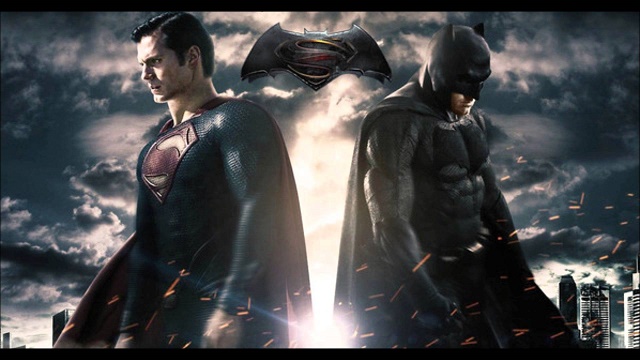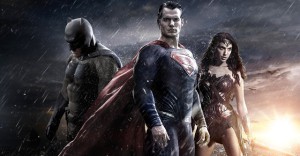Review | Batman v Superman: Dawn of Nihilism and Mansplaining Film
Arts & Culture, Cartoons, Film & TV, New in Ceasefire - Posted on Wednesday, March 30, 2016 12:48 - 3 Comments
By Neal Curtis

Batman vs Superman: Dawn of Justice was a hotly anticipated film primarily because of the long-awaited silver screen meeting of DC’s “big three”. Not only were Batman and Superman going to be in a film together, there was also great excitement over the first appearance of Wonder Woman, played by Gal Gadot.
The film is a curious mix of discontinuity and continuity that, in some sense, plagues the whole story. It marks a new start for Batman with Zack Snyder directing (after Christopher Nolan’s trilogy) and Ben Affleck playing Batman; while it is also a sequel to Zack Snyder’s recent Superman film, Man of Steel. The washed-out, gritty aesthetic Snyder used there is also evident here, and by the end of the movie I felt like I was crying out for some colour, even some light; and although it was pitch black outdoors by the time I left the movie theatre it somehow felt brighter than where I’d just been.
Primarily, this is because the darkness of the film wasn’t just a matter of photographic style. This is probably the most nihilistic superhero film I’ve ever seen. Nolan’s Batman trilogy was violent and dark and, of course, borrowed heavily from Frank Miller’s famous 1986 graphic novel, The Dark Knight Returns, recognised to have been one of the main texts – along with Alan Moore’s Watchmen – to have transformed the genre (I tend to disagree with that, but that is perhaps for another time). The influence of Miller, however, is undeniably enormous and continues in this latest outing.
Although Nolan’s third Batman film was a dystopic vision in which a social revolution turns into the tyranny of a hateful mob that can only be put down by a noble aristocrat like Bruce Wayne, this newest vision of Batman is even darker. There isn’t quite the explicit hatred of democracy we find in the last Nolan film, but Snyder delves further into Batman as an avatar of exceptional politics in times of emergency.
In a sense, Snyder picks up on the theme set out in Nolan’s second film where, five years into the war on terror, and at a time when the Iraqi insurgency was still strong, Batman’s fanatical pursuit of order was shown to bring about the very chaos he was trying to prevent. In the new film, the theme has a much more domestic feel, as Gotham has become increasingly lawless and Batman himself, as he admits early on in the film to Alfred, has needed to become a criminal to deal with it.
As such, Batman has come to encapsulate the darkest aspect of sovereignty; he is emergency powers made flesh (and kevlar). He represents the moment when the sovereign suspends civil and human rights in the pursuit of order or the fight against an enemy.
What Nolan started, then, Snyder pushes all the way. This is the darkest Batman to date, one that is actually very hard to like. The scene pitting him against a kryptonite-weakened Superman is hard to watch, because this isn’t – or really shouldn’t – be Batman.
Miller’s apocalyptic vision, just one of many versions of Batman that have been, and are currently, written, has completely dominated the cinematic version. The new Batman is summed up by one line, directly lifted from Miller’s Dark Knight Returns. When he tries to explain his methods, which now include branding criminals (that’s right, he now brands people), he declares that ‘the world only makes sense when you force it to’. This is the essence of Miller’s Machiavellian, animalistic Batman, and Snyder has whole-heartedly adopted him.
As for Superman, the opening of the film is difficult viewing because we are shown the end of the Man of Steel movie, but this time from the perspective of the bystanders who are dying or being injured. Immediately, the film reminds you of how fundamentally wrong the previous Superman film had been – because no authentic incarnation of Superman would have allowed for that to happen. Yes he cannot save everyone and people do get hurt, but he would never have created a situation where such destruction and loss of life happened because of what he chose to do.
In the comics, while Superman makes terrible mistakes (see for example Brain Azzarello’s run, collected under the title For Tomorrow), he is really about hope – and there is little of that in either of Snyder’s films. What is excellent, though, is the way Snyder deploys Superman into the opposite pole to Batman. Where Batman represents the darkness of emergency powers — the violence, blood and dirt of the exception, that moment where the law is suspended and anything is permissible in the pursuit of order or peace — Superman represents divinity. In the film, he is portrayed as the avatar of good and virtue, a figure whom people literally worship. He becomes a cypher for a meditation on our own desire for a saviour, or the entity that provides what French philosopher Jean-Luc Nancy calls the ‘sovereign finish’, the person or idea that completes, founds and secures our identity.
 Through Batman’s eyes (including a strange premonition scene with a fighting sequence straight out of a bad Steven Segal film,) we see Superman’s absolute power, which Batman believes can never be good. At the heart of the film, then, is a stand-off between these two poles of sovereignty, and in reckoning with this, the film does some great work; showing the two poles are not properly reconcilable and are both deeply dangerous, despite Snyder’s attempt at finding precisely such a reconciliation.
Through Batman’s eyes (including a strange premonition scene with a fighting sequence straight out of a bad Steven Segal film,) we see Superman’s absolute power, which Batman believes can never be good. At the heart of the film, then, is a stand-off between these two poles of sovereignty, and in reckoning with this, the film does some great work; showing the two poles are not properly reconcilable and are both deeply dangerous, despite Snyder’s attempt at finding precisely such a reconciliation.
As the film progressed, I kept thinking “Oh, my god! Wonder Woman is going to be the mediating term here. She is going to show them, and us, that “there is another way!”, but, no, my fan-boy excitement was sadly never realised. When we first see her, in her “civilian” identity as Diana Prince, she sadly looks like a Bond girl in high heels and a revealing dress. She has come to a Lex Luthor event for some undisclosed reason and catches the eye of Bruce Wayne, whose presence there leads to a rather crude set-up of the forthcoming Justice League film that looks like a trailer for a TV series dropped into the middle of proceedings. We discover intriguing revelations about Wonder Woman’s back-story, and where she has been, that will, no doubt, prefigure her solo film outing. She is excellent in the movie’s showdown set-piece, playing her full part in the fight and looking very much the equal of her male counterparts. It is a great scene and absolutely fantastic to see her there.
What we are seeing, then, is the only three superheroes to have been written continuously since the Golden Age of comics, all on screen together. Fantastic! So what is Wonder Woman going to be allowed to offer that is different from the total nihilism of Batman and Superman? Remember, when she first appeared, in 1941, William Moulton Marston wrote her as a hero with a radically alternative mission that would divert the world from its path of bigotry and war.
In a key scene (again, I won’t say where, because, you know, spoilers) she declares that she left Man’s World because men were fatalistically violent and beyond help. This is Marston’s Wonder Woman (although she wouldn’t have left), but in a jaw-dropping moment of patriarchal reassertion, Bruce Wayne silences her protestation by declaring that ‘men are good’. This, in effect, is the only grain of hope we are offered, but it is really a perfect, and pretty shitty, example of ‘mansplaining‘ in which Diana is effectively told she’s got it wrong and doesn’t understand the world. Oh dear.
To close, I would just like to say that both Superman and Wonder Woman were created as avatars of social change. Wonder Woman was a vision of how the world could be improved by power being given to women, while, three years earlier, Superman emerged as a figure advocating social democracy, an agent of change at the time of Roosevelt’s New Deal. In these dark times of endless war, austerity, growing inequality and oligarchy I believe we really, really need Superman to return in this guise. It has happened in the comics, but it would be so good if it could happen in the films. However, if he can’t return at least let Wonder Woman speak!
3 Comments
Film | Review | Batman v Superman: Dawn of Nihilism and Mansplaining – AllMagNews
I have watched this movie twice now and really don’t get the hate it’s not bad in my opinion, it’s not great but it’s not bad. I actually liked this movie more than i liked age of ultron. Actually i think this movie is better than alot of the Marvel movies (not all of them, but some) I love the darker tone of the DC movies.
Jimmy Balls
It’s refreshing to find someone on the internet who actually sees the questions the film is asking about gender and social identity, rather than just making a list of reductions.



[…] Film | Review | Batman v Superman: Dawn of Nihilism and Mansplaining […]